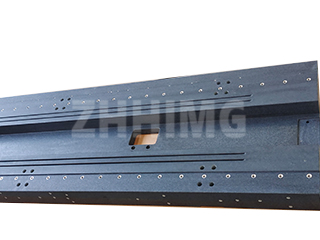In high-precision manufacturing and metrology, granite mechanical components—such as precision beams, gantry frames, and surface plates—are indispensable for their inherent stability. Crafted from naturally aged stone, these components serve as the gold standard for inspecting the flatness and dimensional accuracy of critical mechanical parts. However, even granite, when subjected to extreme conditions or incorrect usage, can exhibit deformation over its long service life.
Understanding the mechanics of these deformations is crucial for mitigating risks and extending the life of your investment. At ZHONGHUI Group (ZHHIMG®), we adhere to strict quality controls to prevent manufacturing defects like sand holes, scratches, or inclusions, but the end-user environment introduces dynamic forces that must be managed.
The Physics of Granite Deformation
While granite is exceptionally rigid and resistant to thermal expansion, it is not impervious to mechanical stress. The primary modes of deformation observed in any structural material, including granite, correspond to the specific forces applied:
- Shear Stress: This type of deformation manifests as a relative lateral displacement within the component. It occurs when two equal and opposite forces act along parallel lines of action, causing sections of the granite component to shift relative to each other.
- Tension and Compression: This is the most straightforward form, resulting in either the elongation (tension) or shortening (compression) of the component’s length. It is typically caused by a direct pair of equal and opposite forces acting along the component’s axial centerline, such as improperly torqued mounting bolts.
- Torsion: Torsional deformation is the twisting of the component around its own axis. This twisting motion is induced by opposing couples (pairs of forces) whose planes of action are perpendicular to the axis, often seen if a heavy load is eccentrically applied or if the component’s mounting base is uneven.
- Bending: Bending causes the component’s straight axis to curve. This is commonly generated either by a single transverse force acting perpendicular to the axis or by a pair of opposing couples applied in a longitudinal plane. In a granite gantry frame, for instance, uneven distribution of load or insufficient support spacing can lead to damaging bending stresses.
Best Practices: Preserving Accuracy with Straightedges
Granite components frequently rely on auxiliary reference tools like granite straightedges to measure linear deviations, parallelism, and flatness over short sections. Using these precision tools correctly is non-negotiable for preserving both the granite reference and the tool itself.
A foundational step is always to verify the straightedge’s accuracy before use. Secondly, temperature equilibrium is key: avoid using the straightedge to measure workpieces that are significantly too hot or too cold, as this introduces thermal error into the measurement and risks temporary deformation of the granite tool.
Most critically, the straightedge should never be dragged back and forth across the workpiece surface. After completing a measurement section, lift the straightedge completely before moving to the next position. This simple act prevents unnecessary wear and preserves the critical working surface finish of both the straightedge and the component being inspected. Furthermore, ensure the machine is safely powered off—measuring moving parts is prohibited as it causes immediate damage and is a safety hazard. Finally, both the straightedge and the inspected surface must be scrupulously clean and free of any burrs or chips, as even a microscopic contaminant can introduce significant measurement errors.
The Role of Cleanliness in Structural Integrity
Beyond simple stain removal, industrial cleanliness is integral to preventing structural issues in heavy mechanical components. Before assembly or servicing of any machine resting on a granite base, thorough cleaning is mandatory. Residual casting sand, rust, or metal chips must be completely removed, often requiring the use of cleaning agents like diesel, kerosene, or specialized solvents, followed by drying with compressed air. For internal cavities of supporting metal structures (like those attached to the granite), applying an anti-rust coating is a critical preventative measure.
When assembling intricate mechanical subsystems onto the granite, such as drive trains or lead screw mechanisms, detailed cleanliness and alignment checks are essential. Components must be free of anti-rust paint before assembly, and crucial mating surfaces should be lubricated to prevent friction and wear. In all assembly operations, especially when mounting seals or fitting bearings, never apply excessive or uneven force. Proper alignment, correct clearance, and consistent force application are the keys to ensuring the mechanical components function smoothly and do not transfer damaging, asymmetrical stresses back into the ultra-stable ZHHIMG® granite foundation.
Post time: Oct-30-2025

